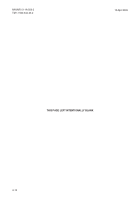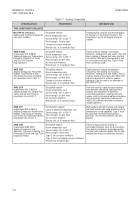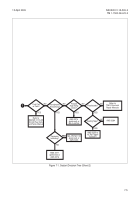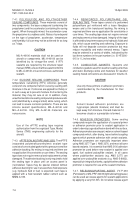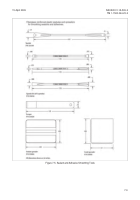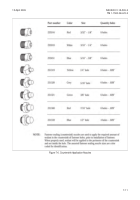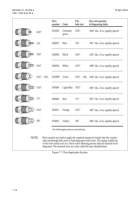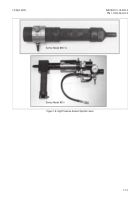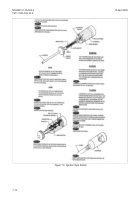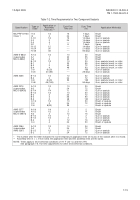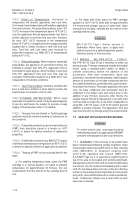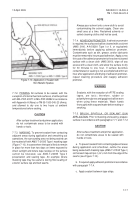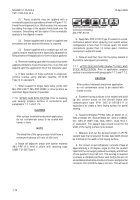TM-1-1500-344-23-2 - Page 126 of 240
7-10
NAVAIR 01-1A-509-2
TM 1-1500-344-23-2
15 April 2009
CAUTION
Care should be taken when using rivet nozzles
to prevent sealant material from filling fastener
holes.
7-5.2. APPLICATION NOZZLES. In addition to the
standard, fillet, and ribbon nozzles in Figure 7-4, the
countersink and rivet nozzles in Figures 7-6 and 7-7,
respectively, can also be used with the sealant guns.
Countersink nozzles are used to apply sealants into the
countersink of fastener holes prior to fastener installation.
Rivet nozzles are used to apply sealants through the
hole prior to fastening parts with rivets. The rivet nozzles
have a spring-loaded tip, which serves as a check valve
and allows for dispensing a precise amount of sealant
material.
7-5.3. HIGH-PRESSURE INJECTION GUN. Figure 7-8
illustrates injection guns used for injecting sealant into
confined holes, slots, structural voids, and joggles,
including channel sealing. Follow the procedures outlined
in the aircraft SRM for the proper preparation and use
of these guns. For hard to reach areas, attach an
extension nozzle to the injection tip.
7-5.4. SEALANT KITS (SEMKIT OR TECHKIT). Most
sealants are available as ready to use kits (Semkits or
Techkits). These kits are compact, two-part mixing
application units designed for convenient storage, easy
mixing, and proper application of the sealant in small
quantities. The base sealant is packaged in standard
2
1
⁄
2
ounce and 6 ounce cartridges which are placed in a
sealant gun for application. There are two styles: the
Barrier style, which holds proportioned amounts of the
two components separated by an aluminum barrier;
and the Injection style, which stores the accelerator
material within the injection rod to separate it from the
base compound prior to use (Figure 7-9). When using
Semkits or Techkits, note that the handle or dasher
contains a pre-measured amount of accelerator and
should be retained until the ramrod has been operated
to release the seal at the bottom of the dasher. All of the
material contained inside the two-component Semkit or
Techkit package is mixed within the cartridge.
7-5.5. SEALANT APPLICATION TOOLS. When
applying or fairing out sealants and adhesives, use the
smoothing tools shown in Figure 7-5. These tools are
commonly used in sealing maintenance work, but other
tools may be manufactured/fabricated as needed to fit
a specific situation. Only phenolic/plastic material shall
be used to manufacture sealant application tools.
7-6. TWO COMPONENT SEALANT MIXING AND
HANDLING.
The proper weighing and mixing of
components is essential to assure proper curing and
adhesion of sealants. Use a weight scale to accurately
measure the materials before mixing. Mixing shall be
accomplished in one central area in each organization.
Polysulfide and polythioether sealants consist of two
separately packaged components, a base compound
(part B) and an accelerator (part A) in 6 ounce, 12 ounce,
and 24 ounce kits. The base-to-accelerator ratio varies
with different manufacturers. It is important, therefore,
to mix the material according to the manufacturer’s
instructions. The accelerator should be added to the
base in the correct ratio and mixed until a uniform color
is obtained. Difficulties with polysulfide and polythioether
sealants are frequently caused by incomplete mixing or
inaccurate weighing. The two-part sealants are
chemically cured and do not depend on solvent
evaporation for curing. Slow mixing by hand is
recommended for two-part can kits. A high speed
mechanical mixer should not be used as internal heat
will be generated, reducing application life and
introducing air into the mixture. Mix Semkit or Techkit in
accordance with manufacturer's mixing instructions.
CAUTION
Do not use any two-part sealant after it has
been mixed and its rated application time has
expired, as poor adhesion may result.
7-6.1. APPLICATION TIME AND CURE TIME. Sealant
application time and cure time are dependent upon
ambient environmental conditions. Maintenance
personnel should be aware of the effects of temperature
and humidity on the application time of a sealant. Mix
only the amount of material that can be applied during
the rated application (work) time of the sealant. This
time (in hours), known as a dash number, is denoted as
the last number in a sealant designation (e.g.
MIL-PRF-81733 Type II-2 has an application time of
two hours). Table 7-2 indicates application times, tack-
free times, and full cure times for each sealant type and
dash number at 75
°
F (24
°
C) and 50% relative humidity.
Back to Top

